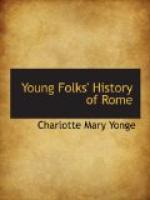[Illustration: CATACOMBS.]
“Go,” said Constantine; “if your faith agree with your oath, you are blameless; if not, God be your judge;” and he commanded that Arius should be received to communion the next day, which was Sunday. But on his way to church, among a great number of his friends, Arius was struck with sudden illness, and died in a few minutes. The Emperor, as well as the Catholics, took this as a clear token of the hand of God, and Constantine was cured of any leaning to the Arians, though he still believed the men who called Athanasius factious and troublesome, and therefore would not recall him from exile.
The great grief of Constantine’s life was, that he put his eldest son Crispus to death on a wicked accusation of his stepmother Fausta. On learning the truth, he caused a silver statue to be raised, bearing the inscription, “My son, whom I unjustly condemned;” and when other crimes of Fausta came to light, he caused her to be suffocated.
Baptism was often in those days put off to the end of life, that there might be no more sin after it, and Constantine was not baptized till his last illness had begun, when he was sixty-four years old, and he sent for Sylvester, Pope or Bishop of Rome, where he then was, and received from him baptism, absolution, and Holy Communion. After this, Constantine never put on purple robes again, but wore white till the day of his death in 337.
[Illustration]
CHAPTER XXXVIII.
CONSTANTIUS.
337-364.
Constantine the Great left three sons, who shared the empire between them; but two were slain early in life, and only Constantius, the second and worst of the brothers, remained Emperor. He was an Arian, and under him Athanasius, who had returned to Alexandria, was banished again, and took refuge with the Pope Liberius at Rome. Pope—papa in Latin—is the name for father, just as patriarch is; and the Pope had become more important since the removal of the court from Rome; but Constantius tried to overcome Liberius, banished him to Thrace, and placed an Arian named Felix in his room. The whole people of Rome rose in indignation, and Constantius tried to appease them by declaring that Liberius and Felix should rule the Church together; but the Romans would not submit to such a decree. “Shall we have the circus factions in the Church?” they said. “No! one God, one Christ, one Bishop!” In the end Felix was forced to fly, and Liberius kept his seat. Athanasius found his safest refuge in the deserts among the hermits of the Thebaid in Egypt.




